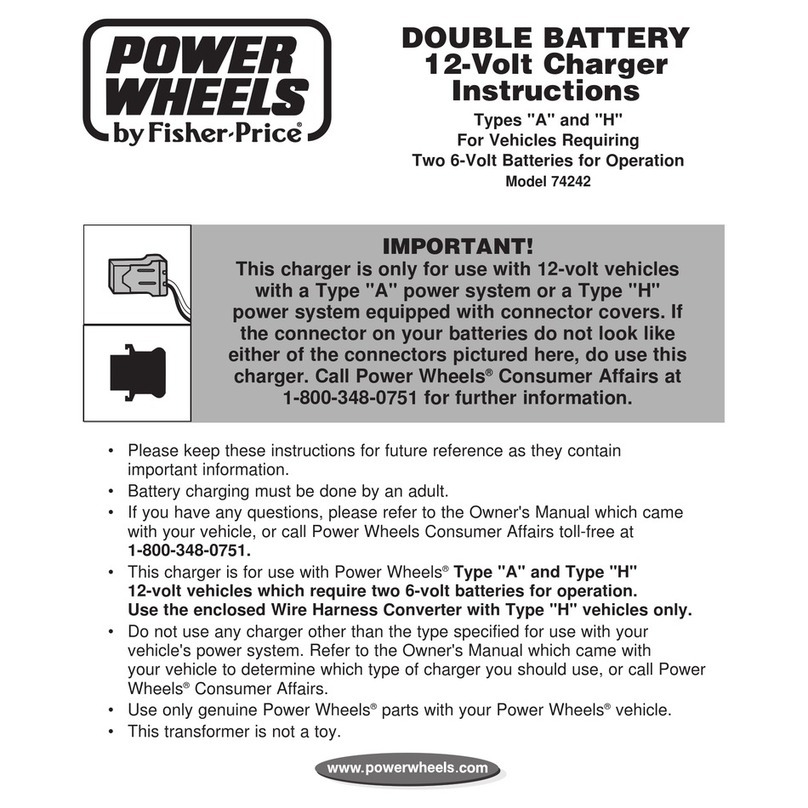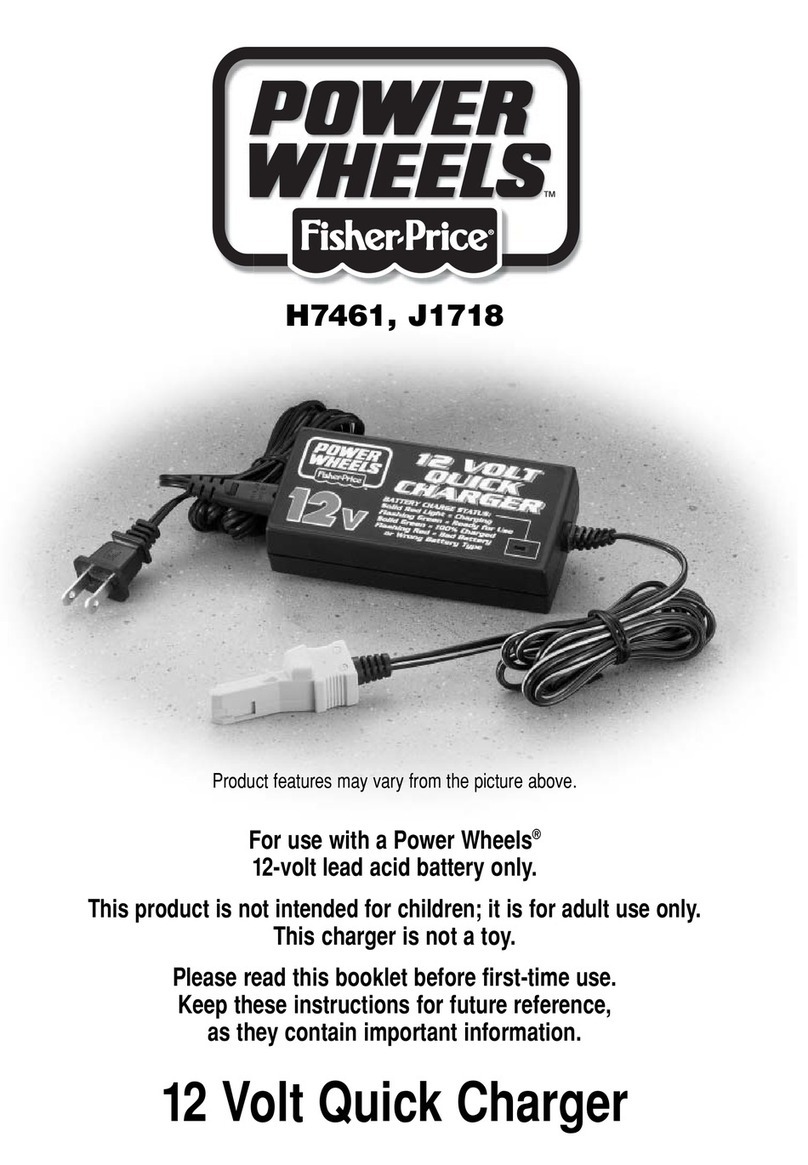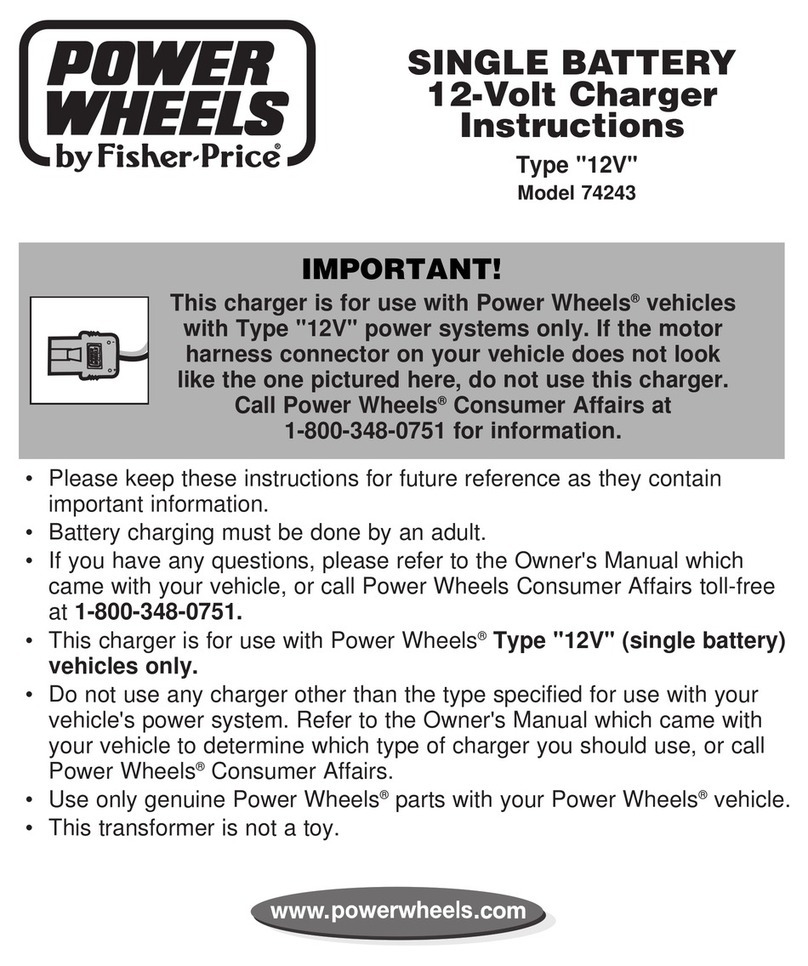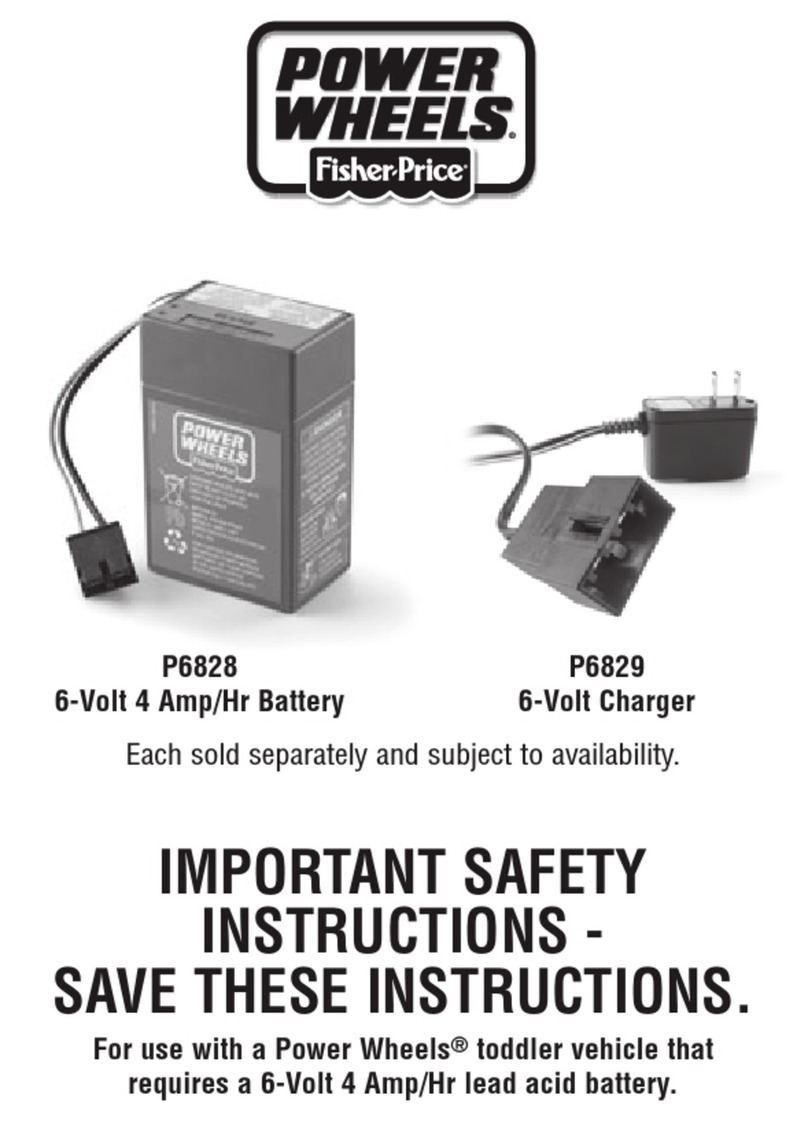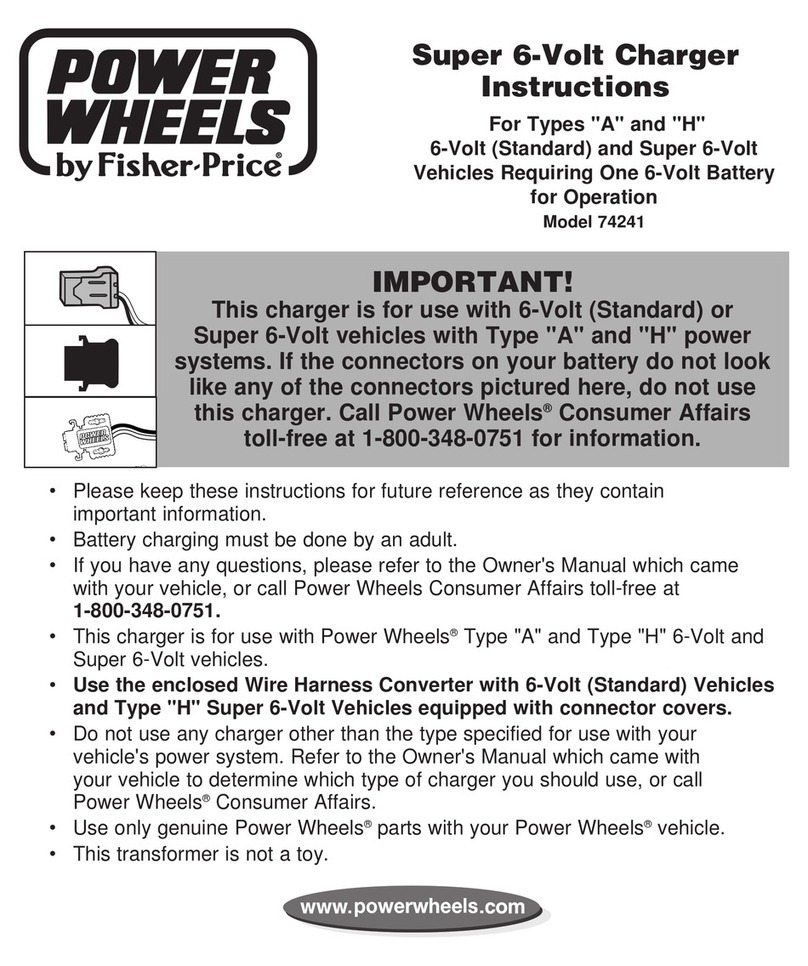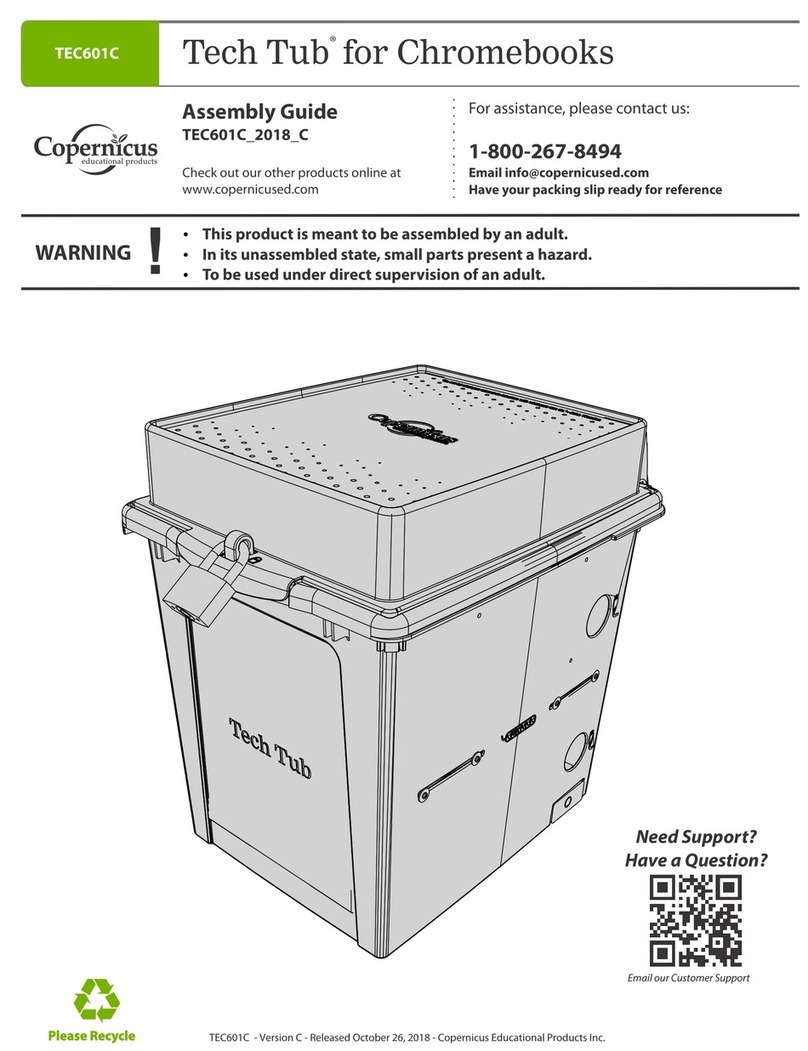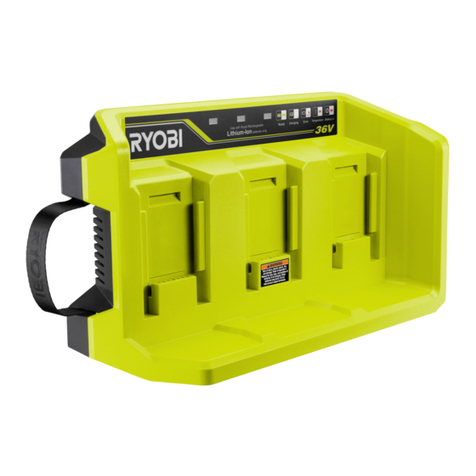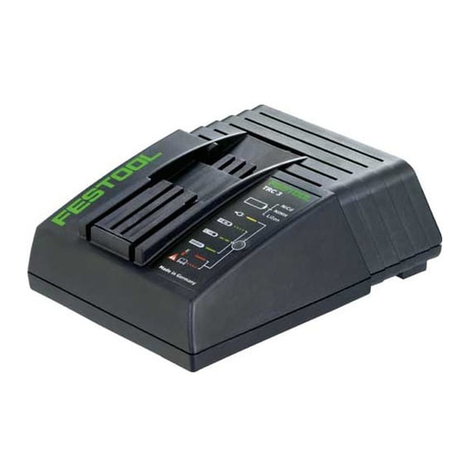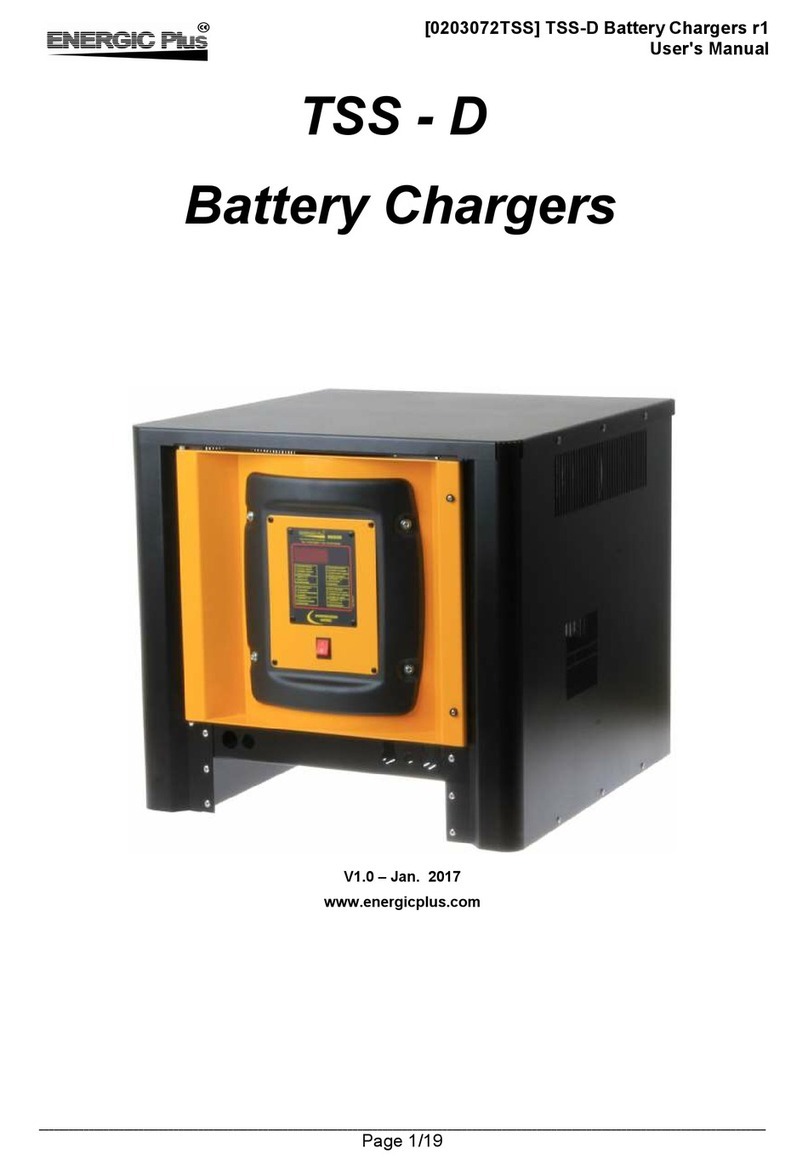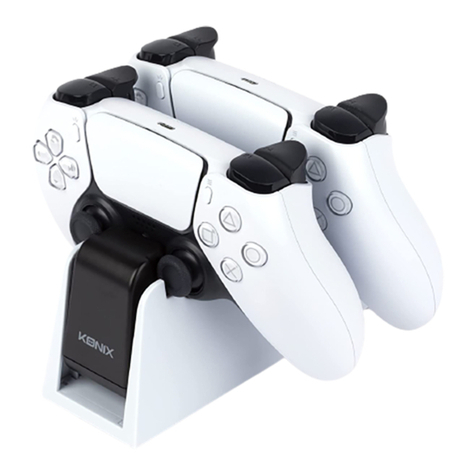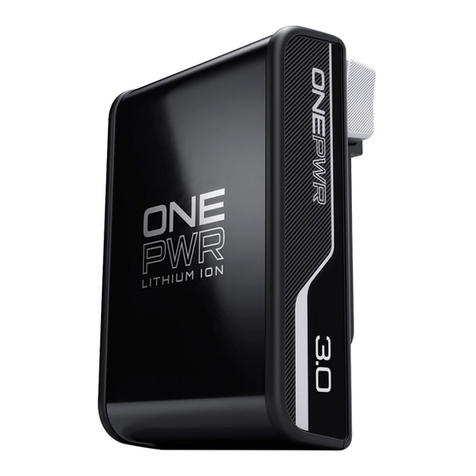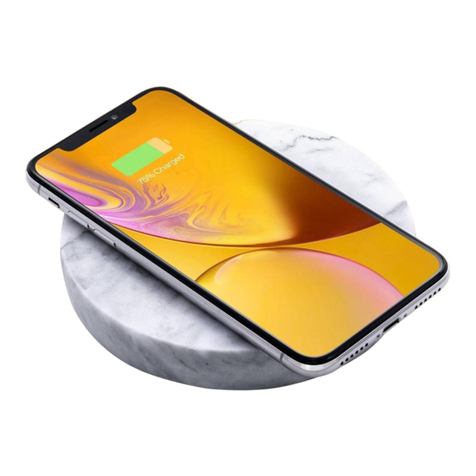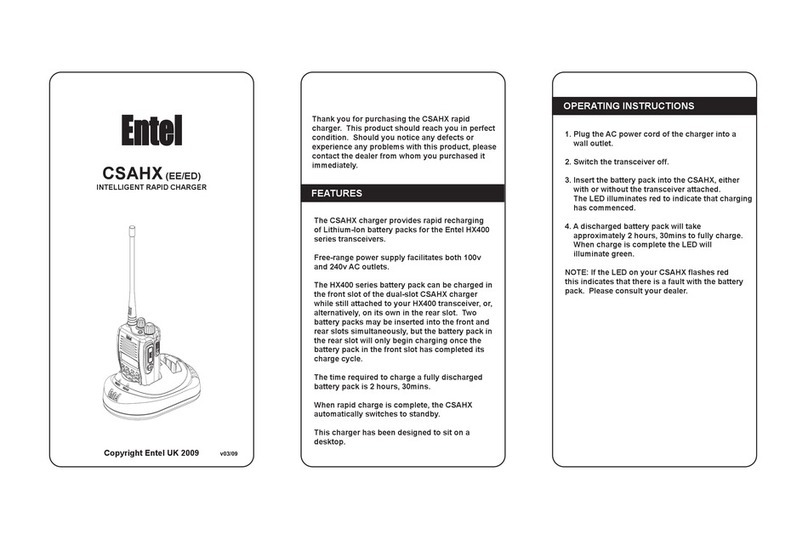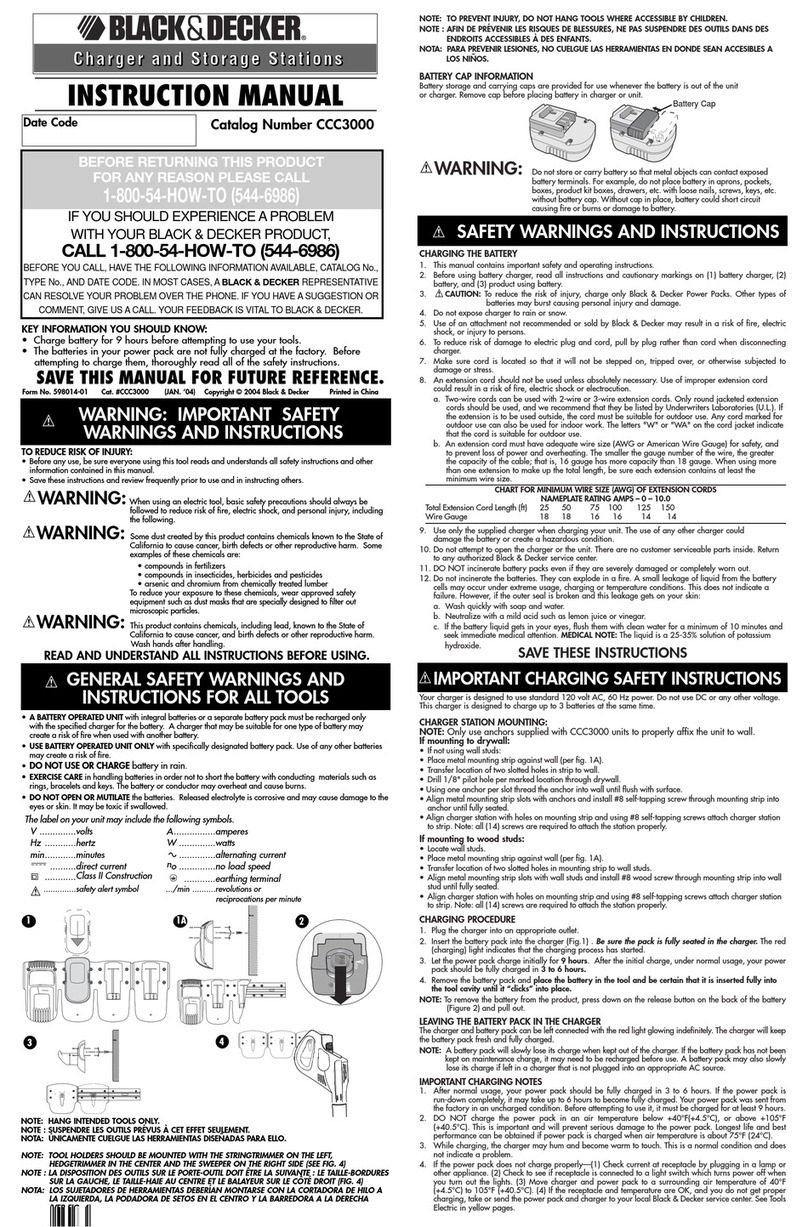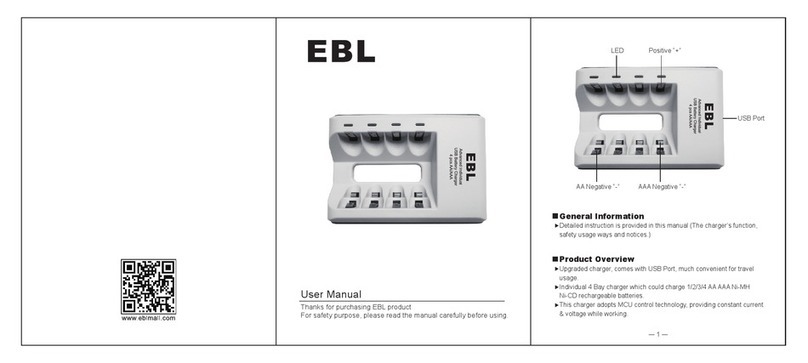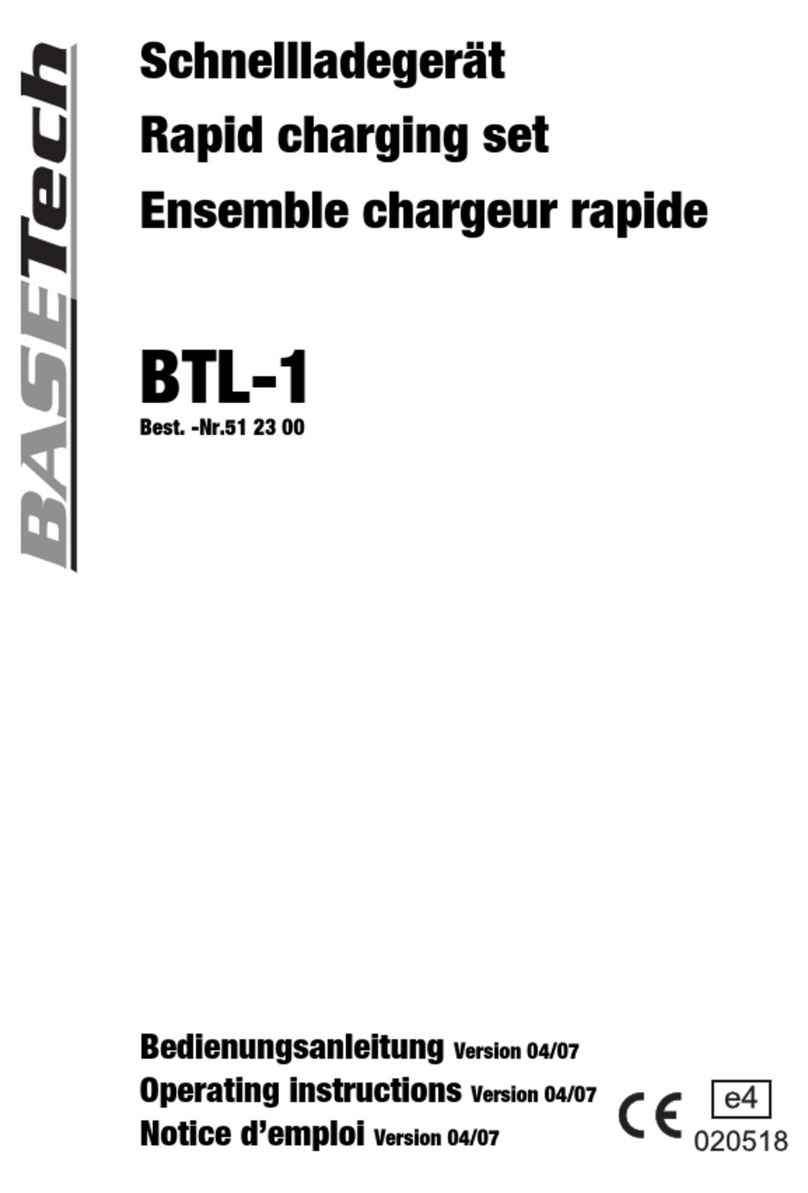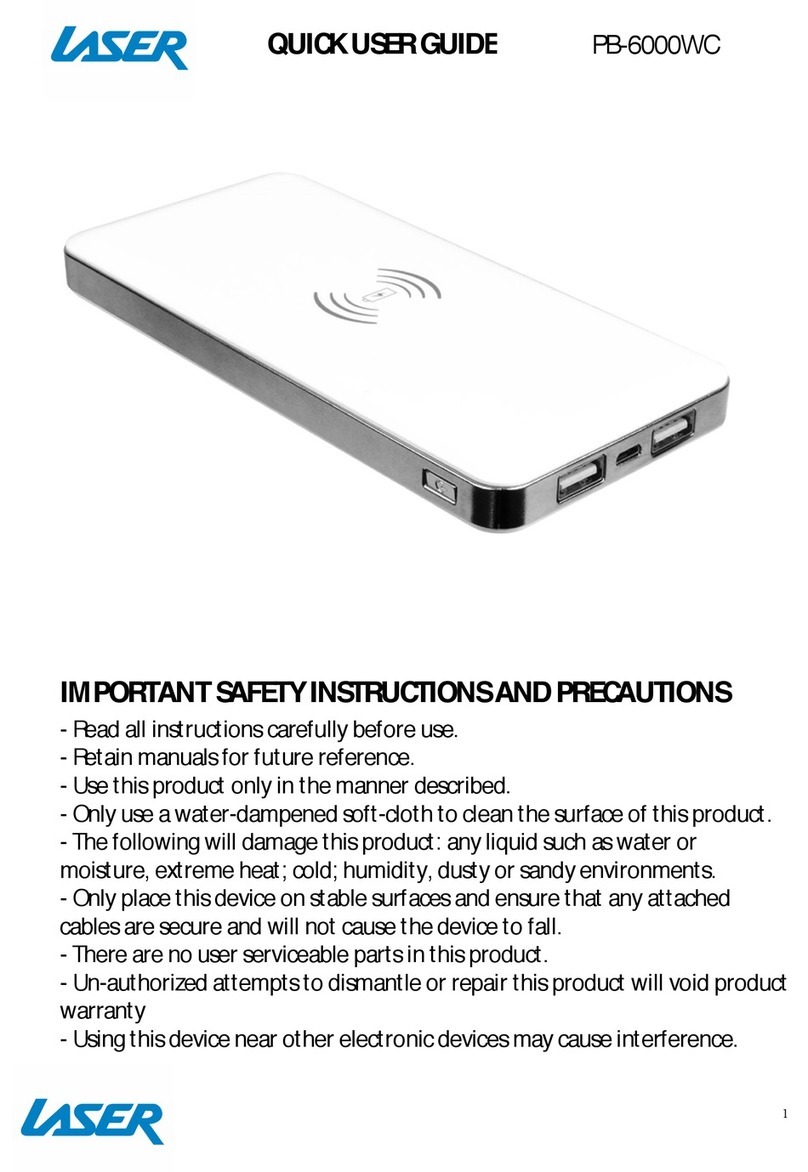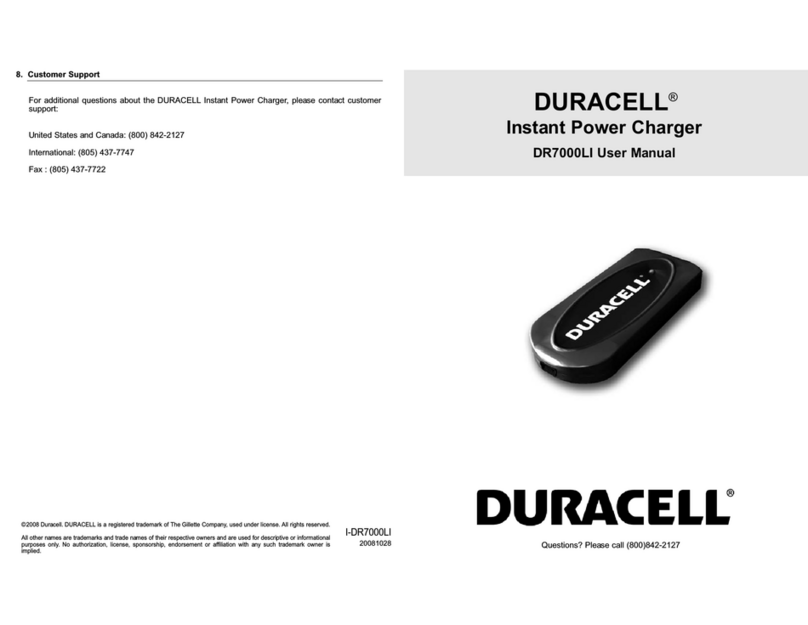Power Wheels FMD26 User manual

FMD26powerwheels.com
12-Volt Quick Charger
Cargador rápido de 12V
Chargeur rapide de 12 V

2
BEFORE YOU BEGIN
• Please read this manual before first-time use and save it with your
original sales receipt.
• Keep these instructions for future reference, as they contain
important information.
• This product does not include a battery. Please use this product
only with a Power Wheels®12V, 12 Ah lead acid battery.
• This product is not intended for children. It is for adult use only.
• This product quickly charges your Power Wheels®12V, 12 Ah
battery in approximately 6 hours.
• Failure to follow these instructions may damage your battery and
will void your warranty.
• Before charging the battery, examine the battery case for cracks
and other damage which may cause sulfuric acid (electrolyte) to
leak during the charging process. If damage is detected, do not
charge the battery or use it in your vehicle. Battery acid is very
corrosive and can cause severe damage to surfaces it contacts.
• Do not charge the battery on a surface (such as kitchen counter-
tops) which could be damaged by the acid contained inside the
battery. Take precautions to protect the surface on which you place
your battery.
• Charge the battery in a well-ventilated area.
• Input: 120/240 VAC 0.8amp 50/60Hz
Output: 12V DC 2.5A

3
WARNING
To prevent fire or injury
• Never modify the electrical system.
Alterations could cause a fire.
• Use only a Power Wheels®battery
and charger. Other batteries or
chargers could cause a fire
or explosion.
• Only adults should charge batteries.

4
• Plug the charger into a wall outlet. The charger LED is blue,
indicating that there’s power.
Note: If the LED is not blue, you may not have power to the outlet.
If there is a switch that controls power to the outlet, make sure
it’s ON.
• Plug the charger into battery. The charger LED should change to
red or green. If it remains blue, make sure the charger is firmly
plugged into the battery.
• Allow 6 hours for a full charge. The charger LED should be green.
Remove the charger connector from the battery and then unplug
the charger from the wall outlet.
• The battery is now ready to be installed in your vehicle. Please
refer to the vehicle Owner’s Manual for instructions to install the
battery in your vehicle.
LET’S GET STARTED
Battery must be upright
while charging.
Do not plug the
charger into
a ceiling outlet.

5
11
0
1
8
9
8
4
20
-
0
1
CHARGER LED
This charger has an LED to indicate charger power and the battery’s
charge status.
LED
Solid Blue - Charger is
plugged into a power
source but not plugged
into the battery.
Solid Green - Battery is
fully charged.
Solid Red - Battery is
charging.
Flashing Red - Battery
is damaged/dead.
Replace the battery.

6
PROBLEMS?
• If the charger operates erratically, you may need to reset the
electronics. Unplug the charger from the wall outlet and then the
battery. Wait 30 seconds. Reconnect in this order:
1) Plug the charger into the wall outlet.
2) Plug the charger connector into the socket in battery.
• Remember, if the LED on the charger flashes red, your battery is
damaged and will not accept a charge. You’ll need to replace
the battery.

7
Adults note: Periodically
examine this battery
charger for damage to
the cord, housing or
other parts that may
result in the risk of fire,
electric shock or injury.
If the battery charger is
damaged, do not use it.

8
• Protect the environment by not disposing of this
product or any batteries with household waste. This
symbol indicates that this product shall not be treated
as household waste. Check your local authority for
recycling advice and facilities.
FCC STATEMENT (UNITED STATES ONLY)
This equipment has been tested and found to comply with the limits
for a Class B digital device, pursuant to Part 15 of the FCC rules.
These limits are designed to provide reasonable protection against
harmful interference in a residential installation.This equipment
generates uses and can radiate radio frequency energy and, if
not installed and used in accordance with the instructions, may
cause harmful interference to radio communications.However,
there is no guarantee that interference will not occur in a particular
installation.If this equipment does cause harmful interference to
radio or television reception, which can be determined by turning
the equipment off and on, the user is encouraged to try to correct
the interference by one or more of the following measures:
• Reorient or relocate the receiving antenna.
• Increase the separation between the equipment and receiver.
• Connect the equipment into an outlet on a circuit different from
that to which the receiver is connected.
• Consult the dealer or an experienced radio/TV technician for help.
NOTE: Changes or modifications not expressly approved by the
manufacturer responsible for compliance could void the user’s
authority to operate the equipment.
This device complies with Part 15 of the FCC Rules. Operation
is subject to the following two conditions: (1) This device may
not cause harmful interference, and (2) this device must accept
any interference received, including interference that may cause
undesired operation.

9
ANTES DE EMPEZAR
• Leer este manual antes de usar el cargador por primera vez
y guardarlo con el comprobante de venta original.
• Guardar estas instrucciones para futura referencia, ya que
contienen información de importancia acerca de este producto.
• Este producto no incluye una batería. Solo usar este producto con
una batería de plomo ácido Power Wheels de 12V, 12 Ah.
• Este producto no es un juguete y solo debe ser manipulado por
un adulto.
• Este producto carga rápidamente la batería Power Wheels de 12V,
12 Ah en aproximadamente 6 horas.
• El incumplimiento de estas instrucciones puede dañar la batería
y anulará la garantía.
• Antes de cargar la batería, verificar que el compartimento de
la batería no tenga rajaduras ni daños que pueden hacer que
se derrame ácido sulfúrico (electrolito) durante el proceso de
carga. Si detecta algún daño, no cargar la batería ni usarla con el
vehículo. El ácido de la batería es sumamente corrosivo y puede
causar daños severos a las superficies con las que entra
en contacto.
• No cargar la batería en una superficie (tal como la cubierta de una
cocina) que se pueda dañar con el ácido contenido en la batería.
Tomar las debidas precauciones para proteger la superficie donde
vaya a colocar la batería.
• Cargar la batería en un área bien ventilada.
• Entrada: 120/240 V~, 0.8amp 50/60Hz
Salida: 12 Vcc, 2.5A

10
ADVERTENCIA
Para evitar incendios o lesiones
• Nunca modificar el sistema
eléctrico. Las alteraciones podrían
causar un incendio.
• Usar solo una batería y cargador
de Power Wheels®. Otras baterías
o cargadores podrían causar un
incendio o explosión.
• Solo un adulto debe cargar
una batería.

11
PASOS PREPARATIVOS
La batería debe estar
en posición vertical
mientras se carga.
• Enchufar el cargador en un tomacorriente de pared. La luz
LED del cargador se pondrá azul, lo que indica que hay
suministro eléctrico.
Nota: Si la luz LED no se pone azul, significa que no hay suministro
eléctrico. Si hay un interruptor que controla el suministro al
enchufe, asegurarse de que esté en ENCENDIDO.
• Enchufar el cargador en la batería. La luz LED del cargador se debe
poner roja o verde. Si sigue azul, asegurarse de que el cargador
esté bien enchufado en la batería.
• Una carga completa se demora 6 horas. Se prenderá la luz LED
verde del cargador. Desconectar el conector del cargador de la
batería y luego desconectar el cargador del tomacorriente de pared.
• La batería está lista para instalarse en el vehículo. Consultar el
manual del usuario del vehículo para mayores detalles sobre cómo
instalar la batería en el vehículo.
No enchufar el
cargador en un
tomacorriente
de techo.

12
LUZ LED DEL CARGADOR
Este cargador incluye una luz LED que indica el suministro al
cargador y el nivel de carga de la batería.
11
0
1
8
9
8
4
20
-
0
1
LED
Luz azul sólida - El cargador
está enchufado en una
fuente eléctrica, pero no está
enchufado en la batería.
Luz verde sólida - La batería
está totalmente cargada.
Luz roja sólida - La batería
se está cargando.
Luz roja centelleante -
La batería está dañada/gastada.
Será necesario sustituir la
batería por una nueva.

13
¿PROBLEMAS?
• Si el cargador no funciona correctamente, restablecer el circuito
electrónico. Desenchufar el cargador del tomacorriente de pared
y luego de la batería. Esperar 30 segundos. Volver a conectarlos
en este orden:
1) Enchufar el cargador en un tomacorriente de pared.
2) Enchufar el conector del cargador en el enchufe de la batería.
• Si la luz LED del cargador centellea en rojo, significa que la batería
está dañada sin aceptar carga. Será necesario sustituir la batería
por una nueva.

14
Atención padres: Revisar
periódicamente que el
cargador no presente
daños en el cable,
compartimento u otras
piezas que pueden resultar
en riesgo de incendio,
descargas eléctricas
o lesiones. No usar el
cargador si está dañado.

15
• Protege el medio ambiente desechando este producto
o baterías de cualquier tipo adecuadamente. Este
símbolo indica que se debe desechar apropiadamente
este producto. Consulta con tu gobierno local en cuanto
a información sobre centros de reciclaje en tu localidad.
NOTA FCC (VÁLIDO SÓLO EN LOS ESTADOS UNIDOS)
Este equipo fue probado y cumple con los límites de un dispositivo
digital de Clase B, según está establecido en la Parte 15 del
reglamento FCC. Estos límites están diseñados para proporcionar
una protección razonable contra interferencia dañina en una
instalación residencial. Este equipo genera, utiliza y puede radiar
energía de radiofrecuencia y, si no se instala y utiliza según lo
estipulado en las instrucciones, puede causar interferencia dañina
a radiocomunicaciones. Sin embargo, no hay ninguna garantía
de que no haya interferencia en una instalación particular. Si este
equipo llega a causar interferencia dañina a la recepción de radio o
televisión, lo cual puede ser verificado encendiendo y apagando el
equipo, se recomienda tomar una de las siguientes medidas para
corregir el problema:
• Cambiar la orientación o localización de la antena receptora.
• Aumentar la distancia entre el equipo y el receptor.
• Conectar el equipo en un tomacorriente en un circuito diferente al
del receptor.
• Ponerse en contacto con el distribuidor o con un técnico de
radio/TV.
Nota: Los cambios o modificaciones no expresamente autorizados
por el fabricante responsable del cumplimiento de las normas puede
cancelar la autoridad del usuario de usar el equipo.
Este dispositivo cumple con la Parte 15 del reglamento FCC. El uso
está sujeto a las dos condiciones siguientes: (1) este dispositivo no
debe causar interferencia dañina y (2) este dispositivo debe aceptar
cualquier interferencia recibida, incluyendo interferencia que pueda
causar que el dispositivo no funcione correctamente.

16
• Lire le présent guide avant la première utilisation et le conserver
avec le reçu de caisse original.
• Conserver ce mode d’emploi pour s’y référer en cas de besoin car
il contient des informations importantes.
• Ce produit ne comprend pas de batterie. Utiliser ce produit
uniquement avec une batterie au plomb Power Wheels®
de 12 V (12 Ah).
• Ce produit n’est pas conçu pour les enfants; il doit être manipulé
uniquement par un adulte.
• Ce produit permet de charger la batterie Power Wheels® de 12 V
(12 Ah) en 6 heures environ.
• Ne pas suivre ces directives pourrait avoir pour conséquences
d’endommager la batterie et d’annuler la garantie.
• Avant de charger la batterie, s’assurer que le boîtier ne comporte
pas de fissures ou de dommages qui laisseraient couler de l’acide
sulfurique (électrolyte) pendant la charge. En cas de dommages,
ne pas charger la batterie ni l’utiliser dans le véhicule. L’acide de
la batterie est très corrosif et peut endommager gravement les
surfaces avec lesquelles il entre en contact.
• Ne pas charger la batterie sur une surface (comme un comptoir de
cuisine) qui pourrait être endommagée par l’acide que contient la
batterie. Protéger la surface sur laquelle la batterie est déposée.
• Charger la batterie dans un endroit bien aéré.
• Entrée : 120 V c.a., 0,8 amp 50/60 Hz
Sortie : 12 V c.c., 2,5 A
AVANT DE COMMENCER

17
AT TENTI ON
Pour prévenir les incendies ou
les blessures
• Ne jamais modifier le système
électrique. Toute modification peut
provoquer un incendie.
• Utiliser uniquement une batterie et
un chargeur Power Wheels
®
. Tout
autre type de batterie ou de chargeur
peut provoquer un incendie ou
une explosion.
• La batterie ne doit être chargée que
par un adulte.

18
• Brancher le chargeur sur une prise murale. Si le voyant du
chargeur est bleu, cela signifie qu’il y a du courant.
Remarque : Si le voyant n’est pas bleu, la prise de courant n’est
peut-être pas opérationnelle. Si la prise est reliée à un interrupteur,
s’assurer qu’il est ALLUMÉ.
• Brancher le chargeur sur la batterie. Le voyant du chargeur devrait
devenir rouge ou vert. S’il reste bleu, s’assurer que le chargeur est
bien branché sur la batterie.
• Une charge complète prend 6 heures. Le voyant du chargeur
devrait être vert. Retirer le connecteur du chargeur de la batterie
puis débrancher le chargeur de la prise de courant.
• La batterie peut maintenant être installée dans le véhicule. Pour ce
faire, consulter les instructions dans le guide de l’utilisateur.
POUR COMMENCER
La batterie doit être debout
pendant la charge.
Ne pas brancher
le chargeur sur
une prise située
au plafond.

19
VOYANT DU CHARGEUR
Ce chargeur est muni d’un voyant qui indique l’état de
fonctionnement du chargeur et le niveau de charge de la batterie.
VOYANT
11
0
1
8
9
8
4
20
-
0
1
Bleu fixe - Le chargeur
est branché sur une prise
de courant mais n’est pas
branché sur la batterie.
Vert fixe - La batterie est
complètement chargée.
Rouge fixe - La batterie
se charge.
Rouge clignotant -
La batterie est endommagée
ou à plat. La batterie doit
être remplacée.

20
PROBLÈMES?
• Si le chargeur ne fonctionne pas correctement, il peut être
nécessaire de réinitialiser le système électronique. Débrancher le
chargeur de la prise de courant puis de la batterie. Attendre 30
secondes. Rebrancher dans l’ordre suivant :
1) Brancher le chargeur sur la prise murale.
2) Brancher le connecteur du chargeur sur la prise de la batterie.
• Si le voyant du chargeur est rouge et clignote, cela signifie que la
batterie est endommagée et ne peut plus être chargée. La batterie
doit être remplacée.
Table of contents
Languages:
Other Power Wheels Batteries Charger manuals
